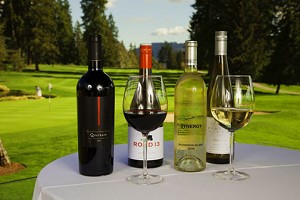Practice ‘Tasting’ Makes Perfects
By Leslee Miller
Coming off of one of the mildest winters to date, Midwesterners are anxious to hit the greens! With the opening of many of our favorite clubs and courses, we stretch to find ourselves readying for another season. Each year we make plans for lessons, practice and more time on the green with hopes of taking our ‘game’ to the next level. And with hard work and dedication, we broaden our skill set to become better with each swing. Golf, much like life, is a game of skill, confidence and hard work. If we don’t practice we don’t succeed, and if we don’t strive to look beyond our own skill set we don’t improve. Oddly, my life as a sommelier is very much the same. If I were to stay stagnant without travel, international in field training and constant practice (yep, that means tasting!), my palate would stick close to home eventually relying on the wines that I’m familiar and feel comfortable with. While it may be the easiest path, it’s not the best advice for anyone looking to take his or her game to the next level.
These thoughts crossed my mind this past month as I ready myself for a keynote speaking position at the CMAA (Club Managers Association of America) Midwest Regional Educational Forum for hospitality, golf and club professionals. How many times have you entered a new season to find that your clubhouse options have not changed? Most culinary departments change on a yearly basis, so why not the beverage programs? Are the same three Pinot Grigios, four Chardonnays and five Cabernets still listed, and are they all wines that can be found in stacks at your favorite retail/bottle shops? Eleven years ago when I began consulting for clubs in the Midwest, I wondered why – if so many memberships were made up of well traveled, well versed and of so many palates – were the same wines, primarily all from California, showing up on every club list? Mostly, I had guessed because many decision makers had been to the wine growing regions of California and felt comfortable with the main grapes: Chardonnay and Cabernet. But, had anyone done the homework, put in the work to step beyond the usual drinking scopes of these grapes and educated their staff and membership as to the world of wine? I get it – life is busy, work is busy and even more so, operating a golf facility from the greens to the food and beverage department is an enormously overwhelming position. But in the end, if many of our golf locations are aligned to be the best in every way, isn’t it also important to keep the membership and our clubs in line with the constantly changing international wine trends? Let’s think about this from a personal perspective – if you continued to use the same clubs, the same stroke and never looked to improve your approach to the game, how would you ever know that ‘better’ existed. Now look at it from a wine perspective, if you never tasted Vermentino, then how would you ever know that if you liked Pinot Grigio, then you might like Vermentino as a grape, too?
The very rewarding part of my career is turning folks on to new grapes, new regions and new styles. If we stopped treating the world as if they only understood three grapes and opened the world of wine up to the ‘style’ of wine, then we might just start looking at wine a bit deeper. Instead of pigeonholing oneself as a ‘Cabernet’ drinker and looking more into the ‘style’ of wines that you drink on a daily basis and what you actually like about them, then you might be open to trying other wines of the same category. Let’s take Cabernet, for instance. One of the statements I hear most often about the grape is, ‘I like it because it’s big, it’s full and it has structure.’ But did you know that wines from the Douro Valley of Portugal representing grapes like Touriga Franca and Touriga Nacional and the west coast regions of Italy, like Campania, hold a grape called Aglianico that live in the same categorical style of ‘full bodied red wines’? It’s true! The world of wine holds over 10,000 grape varietals, many of which we’ll never have the time to try. So if you were willing to look (just a teeny bit outside) of the three grape varietals that you generally drink, you might just find that one or even maybe a handful of grapes that would fit your style of drinking. See? Wine does take practice! And, it does take work. Educating oneself, or even suggesting to your favorite golf establishments, a variance of international grapes and styles might just improve your wine knowledge and sharpen your overall wine ‘game’ making you better equipped for when you’re put into that position of selecting your next round of wine. Besides, wine homework sounds a lot easier than lowering your handicap!
Looking to take your palate to the next level, visit my website @ amuseewine.com for a slew of class opportunities, tastings and more!








